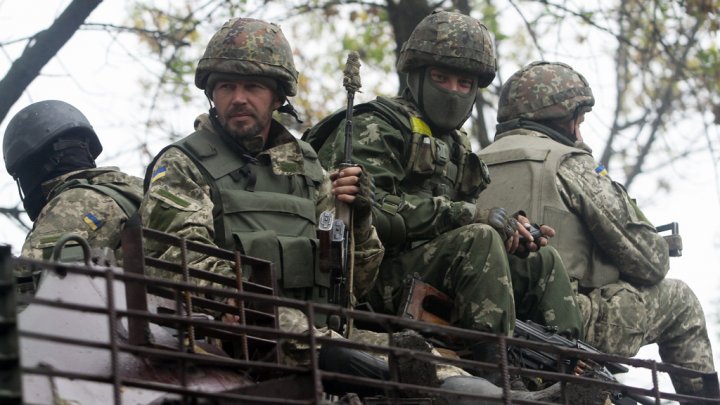
Russian Military Presence Enforces Division of Ukraine’s Donbas
Publication: Eurasia Daily Monitor Volume: 11 Issue: 173
By:

The armistice, slowly taking hold in Ukraine’s Donetsk and Luhansk provinces (collectively known as the Donbas region), basically consigns parts of those territories to Russia’s military and political control, both directly and through local proxies. Facing Russia one-on-one, on the battlefield as well as in the negotiation format, Ukraine was left with no other realistic choice.
The September 5 and September 19-20 agreements, imprecise and loophole-ridden though they are, can lay the basis for a solid and durable ceasefire to Russia’s advantage. This arrangement is enforceable to the extent that Russia will deem expedient to cooperate in enforcing it, militarily and politically (see EDM, September 10, 11, 23, 24).
On the Ukrainian and, even more so, on the Western side, the basic concept of this arrangement is to concede enough to induce Russia to stop further offensive military actions—its own and its proxies’. The hope is that Russia will stop at the armistice lines now being drawn within Ukraine’s territory, and not overstep these lines in the future.
In this sense, Western diplomacy is on track to achieve the core objective it pursued (with varying nuances and in varying degrees) since the outset of Russia’s war against Ukraine. That basic objective is to “de-escalate” the local conflict and the crisis that ensued between Russia and the West. “De-escalation” was conceived as a goal in itself. It became a short-term expedient, not a means toward an outcome that would have reflected a long-term vision of Western interests in Ukraine and the wider region.
Similarly, having the armistice implemented in this form is a goal in itself for Kyiv (it had no other option) as well as for Washington, Brussels or Berlin (they eschewed other options). They do not view this armistice arrangement as a means to achieve a more favorable outcome eventually. Rather, they view it as another case of managing a “frozen” conflict, with acceptance of Russia’s faits accomplis for an indefinite duration. Moscow, however, is undoubtedly considering its options for using its positions in Donbas as a springboard to increase its influence in Ukraine (see below).
Under the armistice agreements, the “sides to the conflict” are to cease combat and other military actions, establish demarcation lines between their forces on the ground, with the buffer zone between them, and withdraw their heavy and long-range weaponry beyond the conflict theater. Both of the armistice agreements imply unmistakably (and, for a trapped Kyiv, inescapably) that the conflict is one between Kyiv and the Donetsk-Luhansk “people’s republics” (DPR, LPR), not Moscow. Instead, Russia is cast in the travesty role of an armistice supervisor, alongside the Organization for Security and Cooperation in Europe (OSCE). The ongoing armistice implementation procedures are laying a basis for the continuation of Russia’s armistice-supervisory role in the years ahead.
Since September 26, a joint center for ceasefire control and coordination has begun operating. A working group from that center conducts inspection visits in the field. It assists Ukrainian and “DPR-LPR” forces to observe the ceasefire, ensure the separation of forces, as well as to establish the ceasefire lines and the buffer zone. This mechanism consists of Russian and Ukrainian military officers (led by a lieutenant-general on either side) and members of the OSCE’s Special Monitoring Mission (SMM—a civilian mission operating in Ukraine since May). Apparently, Russian officers “mediate,” meetings alternately with “DPR-LPR” forces in their territory and with the Ukrainian officers in the joint working group in Soledar (Ukrainian-controlled town in the Donetsk province). OSCE representatives attend the Soledar meetings. Very little is known about this process publicly. Official handouts are scarce, and media reports sketchy (Unian, Ukrinform, sprotyv.info, September 26–30; OSCE SMM report, September 28).
Firing incidents recur, but the overall level of hostilities—and, correspondingly, of casualties—is markedly subsiding, notwithstanding the recent days’ attacks on the Ukrainian-held airport just outside of Donetsk (Kyiv Post, September 29; Interfax, September 30; Kyiv Post, October 1). The Ukrainian president and government emphasize the value of minimizing Ukrainian casualties, particularly among volunteer units.
A process of simplifying the ceasefire lines, straightening and shortening them, is underway since the signing of the armistice agreement. This process mainly affects Ukrainian units holding out under pressure in forward positions, e.g., the Debaltseve salient (with its logistical node) and the Donetsk airport. In the conflict theater’s southeastern corner, Russian and proxy forces stand on the approaches to Mariupol (they arrived there directly from Russia’s contiguous Rostov oblast, not from the far-off Donetsk).
According to unconfirmed, partially credible rumors, some territorial tradeoffs are being discussed in the context of straightening and shortening the ceasefire lines. At least one meeting of all the parties (Ukraine, Russia, “DPR,” “LPR,” OSCE) is known to have been held as part of the process of delineating the Ukrainian zone, the DPR-LPR zone, and the buffer zone (in Horlivka) (OSCE SMM report, September 28). There is no mitigating Western input into this Russian-enforced process.
Russian forces in Ukraine’s territory, coupled with invasion-ready forces on the uncontrolled border, are the driving factors in the partition of Ukraine’s Donbas. Under that protection, the “DPR” and “LPR” are rushing their “parliamentary” elections to formalize the territorial division.
Russia’s military intervention with conventional forces from August 24 onward has recaptured significant territory that Ukrainian forces had liberated prior to that date. The military demarcation lines are those obtained on the date of the ceasefire (with some possible corrections—see above). Those lines are now, on the whole, rapidly crystallizing into political dividing lines.




